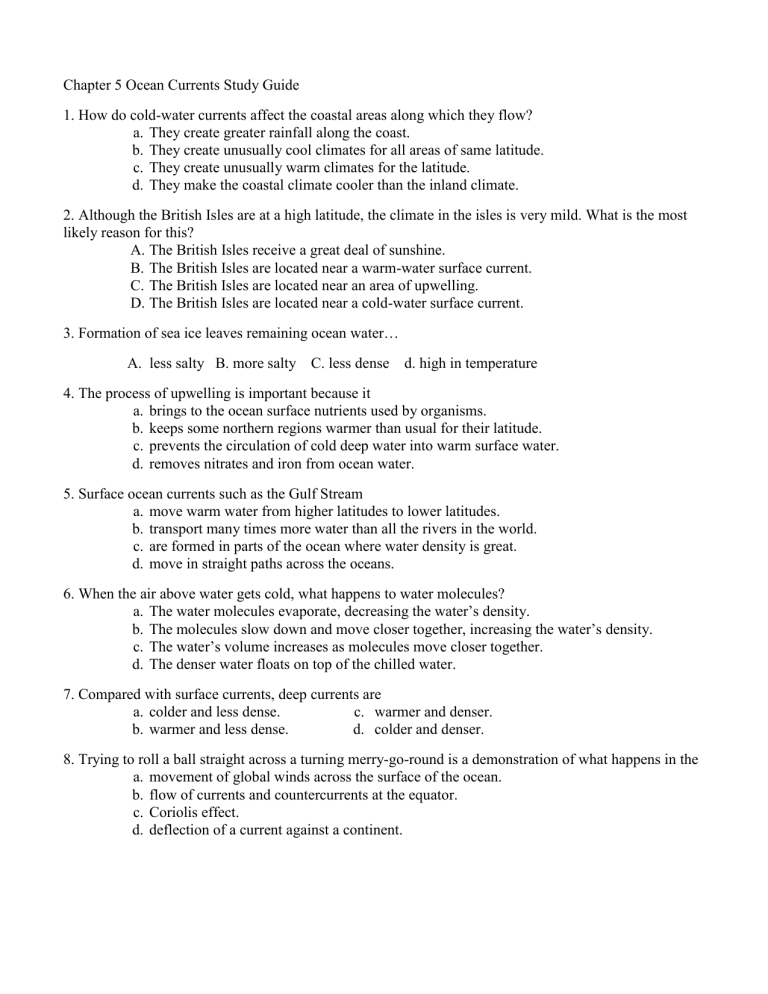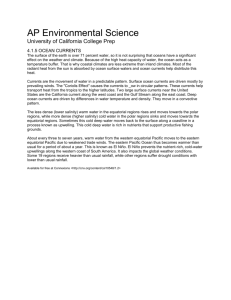Ocean Currents Study Guide: Climate, Upwelling, El Niño

Chapter 5 Ocean Currents Study Guide
1. How do cold-water currents affect the coastal areas along which they flow?
a. They create greater rainfall along the coast.
b. They create unusually cool climates for all areas of same latitude.
c. They create unusually warm climates for the latitude.
d. They make the coastal climate cooler than the inland climate.
2. Although the British Isles are at a high latitude, the climate in the isles is very mild. What is the most likely reason for this?
A. The British Isles receive a great deal of sunshine.
B. The British Isles are located near a warm-water surface current.
C. The British Isles are located near an area of upwelling.
D. The British Isles are located near a cold-water surface current.
3. Formation of sea ice leaves remaining ocean water…
A. less salty B. more salty C. less dense d. high in temperature
4. The process of upwelling is important because it
a. brings to the ocean surface nutrients used by organisms.
b. keeps some northern regions warmer than usual for their latitude.
c. prevents the circulation of cold deep water into warm surface water.
d. removes nitrates and iron from ocean water.
5. Surface ocean currents such as the Gulf Stream
a. move warm water from higher latitudes to lower latitudes.
b. transport many times more water than all the rivers in the world.
c. are formed in parts of the ocean where water density is great.
d. move in straight paths across the oceans.
6. When the air above water gets cold, what happens to water molecules?
a. The water molecules evaporate, decreasing the water’s density.
b. The molecules slow down and move closer together, increasing the water’s density.
c. The water’s volume increases as molecules move closer together.
d. The denser water floats on top of the chilled water.
7. Compared with surface currents, deep currents are
a. colder and less dense. c. warmer and denser.
b. warmer and less dense. d. colder and denser.
8. Trying to roll a ball straight across a turning merry-go-round is a demonstration of what happens in the
a. movement of global winds across the surface of the ocean.
b. flow of currents and countercurrents at the equator.
c. Coriolis effect.
d. deflection of a current against a continent.
Use the diagram below to answer question 9.
9.Which of the following most directly affects the direction of the Gulf Stream current?
A. full moon
B. continental deflection
C. upwelling
D. water density
10. Kelp are giant seaweeds that grow in clear, shallow coastal waters. They attach to rocks with a holdfast and grow long, leafy blades that extend to the surface. These blades create a floating kelp forest, which provides a habitat for animals such as eels, sponges, sea stars, and sea otters. Kelp require cold, nutrient-rich water and light in order to survive. Which ocean process supports the kelp forest?
A. cold-water surface currents
B. warm-water surface currents
C. upwelling
D. deep currents
11. The so-called ocean conveyor belt is driven by….
A. Hurricanes
B. Plate tectonics
C. Differences in water temperature and salinity
D. Gravitational attraction of the Moon
12 . Southern California has cooler temperatures than Arizona, which is at the same latitude. What causes this temperature difference?
A. a cold-water surface current off of California’s coast
B. winds that form high in the California mountains
C. the shade provided by the large number of trees in California
D. the large longshore current running along California’s coast
13.How do warm-water currents affect the coastal areas along which they flow?
A. They create greater rainfall along the coast.
B. They create unusually cool climates for the latitude.
C. They create unusually warm climates for the latitude.
D. They make the coastal climate cooler than the inland climate.
14. Which of the following processes increases the density of ocean water?
a. Melting water from thawing ice flows into the ocean.
b. Warm winds increase the water temperature.
c. Evaporation of surface water leaving solids behind. d.Warm water rises from deep currents to replace water leaving surface currents.
15. How do temperature differences in the ocean help cause ocean currents?
A. Temperature differences in the ocean make fish and mammals swim around, causing currents.
B. Temperature differences in the ocean cause convection currents that transfer thermal energy.
C. The earth's rotation heats the water, which then moves in an ocean current.
D. The wind blows across the ocean’s surface, transfers energy to the water, and makes it move in a current.
16. Which statement describes the negative effects of El Niño?
a. El Niño appears every 2 to 12 years.
b. Rain, flash floods, and mudslides occur in places where there is usually little rain, while usually wet areas suffer from drought.
c. Sometimes El Niño is followed by La Niña, during which ocean temperatures become cooler. d.Upwelling along the coast of South America occurs after an El Niño
Use the diagram to answer numbers 17 and 18.
17. What will the climate be like on the east coast of Australia?
A. Cold B. Warm C. snowy D. frosty
18. What will the climate be like on the west coast of South America?
A. Desert B. Warm C. Cold D. Tropical
19. Some currents flow in large rotating loops called ….
A. Coriolis
B. Westerlies
C. Gyres
D. Upwellings
20.It is important for scientists to learn as much as possible about El Niño because the weather pattern
a. has so far been completely unpredictable.
b. affects North America more than any other continent.
c. has so many effects on organisms and land.
d. can only be studied out in the open ocean.
Use the picture to answer number 21.
21. Considering what you know about the density of cold, salty water, using the map above, where does the oceans conveyor belt begin ?
A.
Around the equator
B.
In the Indian Ocean
C.
In the Arctic Ocean
D.
In the Atlantic Ocean
22. How long will it take for the ocean conveyor belt to make one trip around the world?
A.
10 years
B.
100 years
C.
1 million years
D.
1000 years
Use the table below to answer question 23.
Year
Ocean
Temperature
Rainfall (in.)
1983
25.5
6.6
1985
22
4.2
1997
26.5
7.2
2000
22
4.2
23. The average ocean temperature is 22º C. The average two-month’s rainfall over land near the ocean is 4.2 inches. How does the data in the table demonstrate the relationship between ocean temperature and weather in nearby landmasses? a. The table shows that when the temperature decreases, the rainfall increases in the nearby landmasses. b. The table shows that when the temperature increases, the rainfall decreases in the nearby landmasses. c. The table shows that when the temperature increases, the rainfall increases in the nearby landmasses. d. There is not enough data available to draw conclusion.
Use the map to answer questions 24 and 25.
____
24. Which of the following currents is a warm-water current? a. Canary current b. California current c. North Atlantic Drift d. Peru
25. How do you think the Labrador Current affects the climate of Canada and Greenland? a. The Labrador Current would likely bring a warm climate to Canada and Greenland. b. The Labrador Current would most likely bring a cool climate to Canada and Greenland. c. It would not affect the climate in any way. d. It wouldn’t because the North Atlantic Drift would bring warm waters into that current
cancelling the effect of the Labrador Current on the climate.








